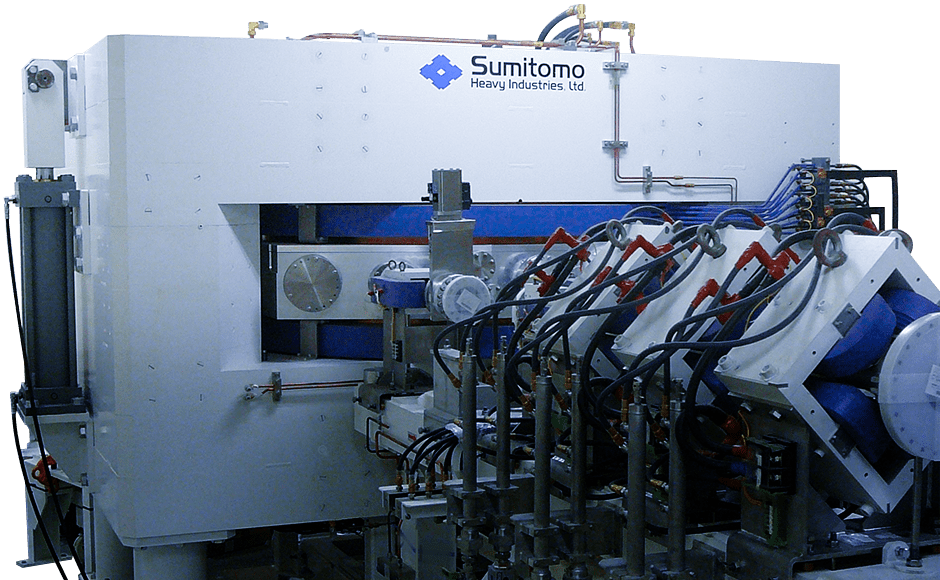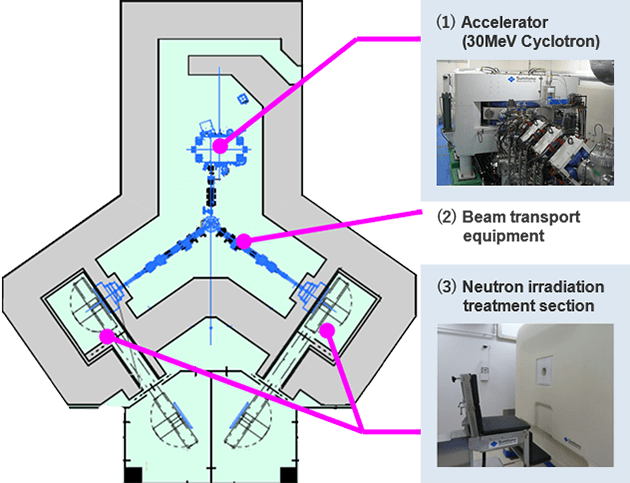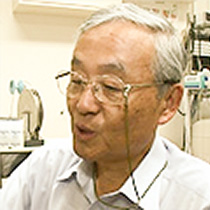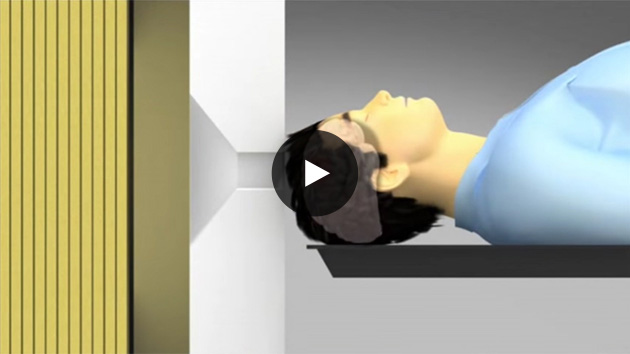Treating Cancer through the Use of Neutrons

The benefits of radiation therapy are that cancer can be treated without resecting the structure of organs while not harming its shape and functions. In this volume, we introduce one such radiation techniques called the neutron capture therapy method. This method of cancer treatment is named as such because a specified element is injected into the body to make it easy to absorb neutrons in cancer cells. From there, neutron rays are shot at that part of the body, selectively destroying the cancer cells. Up to now, a large-scale reactor facility was required to generate the neutrons required for the treatment. However, SHI has developed a compact neutron generator that incorporates an accelerator into its overall system. This development is anticipated to revolutionize radiation therapies that utilize neutrons.
Destroying only those cancer cells that have been injected with boron
Existence of neutrons was physically proved in 1932. Shortly after that, researchers started to propose ideas to utilize such neutrons in medical treatments. The idea that became reality was the neutron capture method which called for the injection of a specified element into cancer cells and to irradiate neutron rays on such cells to cause damage to the cancer cell. In 1950s, the first treatment of cancer (brain cancer) using an experimental reactor was carried out in the United States.
In Japan, clinical studies on the use of the neutron capture method commenced in 1968. The development of a boron compound, which was found to be easy to incorporate into cancer cells, allowed researchers to carry out multiple clinical studies of this treatment method on brain cancer. One of these research facilities, the Kyoto University Research Reactor Institute (located in Kumatori-cho, Sennan-gun, Osaka) commenced clinical treatment in 1975. Today, it is commonly known that Japan leads the world in Boron Neutron Capture Therapy (BNCT) research.
In BNCT, the boron compound is first injected into a patient through an intravenous drip or other means. Once it has been verified that cancer cells have selectively incorporated the boron into its structure, the patient is radiated with neutrons (thermal neutrons) that have energy levels that are appropriate to the treatment. When this is done, the boron and neutrons cause a nuclear fission reaction and the cancer cells that have incorporated the boron molecules are destroyed.
The introduction of a compact accelerator that can be installed at private medical facilities makes reactor facilities redundant.

This method of cancer treatment is a breakthrough because it selectively destroys cancer cells while not harming the surrounding non-cancerous cells. However, the widespread use of this treatment hit a few roadblocks. The first issue was related to the technology behind the boron compound that would be incorporated into the cancer cells. The only isotope of boron that easily causes a nuclear fission reaction is called Boron-10. This isotope needed to be extracted at high concentrations from naturally occurring boron. When the fluorine compound manufacturer, Stella Chemifa Corporation, developed this technology, advancements in BNCT took a huge leap forward.
The other problem was related to the device that would generate the neutrons. Up to now, clinical studies of this treatment method have only been possible at facilities that have a research grade nuclear reactor. These reactors are too large to install such equipment at smaller research or medical facilities. In reality, there was a need for a company to develop a compact neutron generator.
This is where the SHI Group comes into the picture. Through the use of our know-how in PET (positron emission tomography) and proton cancer therapy systems, we were able to develop a compact BNCT accelerator (cyclotron). Since the fall of 2012, clinical trials on BNCT using an accelerator for the first time in the world have been carried out jointly with the Kyoto University Research Reactor Institute and Stella Chemifa Corporation. Further clinical trials to verify the safety of this method will be conducted in the future with the aim to submit an application for approval of medical equipment during 2016 and to obtain an approval of medical equipment.
Technology that achieved significant output from a small device. Clinical trials continue in Osaka and Fukushima.

SHI's BNCT system consists of a cyclotron that emits high powered protons, a beam transportation system that carries the protons to the treatment device, and a neutron irradiator that collides the protons against a metal target (beryllium) to generate neutrons and decelerates the energy of the neutrons before irradiation on a patient.
In the cyclotron, the negative ion of a hydrogen molecule is accelerated. By externalizing the source of ions that generate the negative hydrogen ions, it was possible to make the overall device much smaller while at the same time realizing significant output levels of 30MeV/1mA. Innovation can also be seen in the cooling method of the beryllium target. Unless heat is removed efficiently from this process, the metal target is damaged quickly. In SHI's system, the proton beam follows a circular path to reduce the concentration of heat on the surface of the beryllium, and the cooling water is circulated in a spiral format to effectively achieve heat removal. Even in the material used to decelerate the energy of the neutron, many attempts of trial and error were carried out to find the optimal shape and ratio of metal alloy in the material's composition.
In addition to the clinical trials being carried out at the Kyoto University Research Reactor Institute presently, plans are being made to commence clinical trials at the Southern Tohoku Research Institute for Neuroscience (located in Koriyama City, Fukushima Prefecture) in 2015. This institute is a cutting-edge treatment facility which boasts the first proton therapy device installed at a private medical facility among other equipment. Through the collection of results from the BNCT trials in both Osaka and Fukushima, SHI is aiming to write a new page in advanced cancer treatment methods.
Customer Viewpoint
Next Level of Medical Technology is Opened

Particle Radiation Oncology Research Center
Kyoto University Research Reactor Institute
There is an actual case where a patient underwent BNCT for a cancerous mole (malignant melanoma) that was found on the patient's face. Surgical removal of the mole was difficult because the affected area was quite large and the cancer cells had infiltrated beneath the skin's surface. Treatment through the use of x-rays was also not effective. However, when we treated the cancer cells using BNCT, we found that the growth had clearly degenerated, and the patient's face was returned to almost its normal state. It was an astounding result that I did not even believe at first.
The ability to selectively attack cancerous cells while not damaging the surrounding organs and not resecting its structure. This unique feature of BNCT is what makes it a truly revolutionary, almost next-dimensional treatment technology in the field of cancer research. Presently, it is not possible to apply this treatment technology to all forms of cancer but at our research facility, we are carrying out clinical trials and collecting resultant data on various forms of cancer including recurrent brain tumors, malignant melanoma, and recurrent head and neck cancer, among others.
In addition, up to now, a nuclear reactor to generate the neutrons required for this treatment method was necessary. However, through joint research activities with SHI, we have succeeded in developing a BNCT system that utilizes a compact accelerator. This has allowed us to take another big step forward in the development of medical treatments that can be put to practical use. In the not-so-distant future, our dream is that all patients that need it will have access to this new treatment method.
- *All contents are as of the time of the interview.
SHI Pride
- Vol.1 A Clear View of the Distant Heavens
- Vol.2 Cures without Surgery: Advanced Cancer Treatment
- Vol.3 Exploring the Mysteries of Space
- Vol.4 Dramatically Changing Quayside Cargo Handling
- Vol.5 Cyclo® Drives Continue to Evolve
- Vol.6 The Steam Turbine - Protecting the Environment and Advancing Society
- Vol.7 Persistent Determination to Reduce Defects, Losses and Faults to Zero
- Vol.8 Treating Cancer through the Use of Neutrons - A Compact Accelerator Opens the Door to Widespread Use -
- Vol.9 Automated storage system with unrestricted movement, for transforming the future of the logistics industry
- Vol.10 Anaerobic Wastewater Treatment and Biogas Power Generation System using Ume Seasoning Effluent bringing Recycling-Friendly Society


